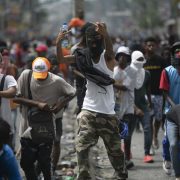
Perhaps one of the problems at the heart of the present controversies between China, the United States, and other countries is very cultural with practical implications in real politics: the keystone issue of balance of power, crucial for all Western civilization.[1]
Traditionally, historians claim that the idea of balance of power came about with the Greek city states and the Byzantine empire. Constantinople was the most powerful entity in that part of the world, yet it still could not muster the strength necessary to push down its enemies and create political and military alliances and diplomacy, which would pit enemies against one another and allow it to emerge as the arbiter in the controversies.
Still perhaps this idea came about at the height of the Roman empire. In the 3rd century, Emperor Diocletian split the empire in two, as he recognized that unitary control was impossible, and therefore it was easier to carve out a minor power in the east. His successor Constantine established the alternative capital in the east: Constantinople, which then with time rivaled and even surpassed the power of Rome. Then the two halves of the empire had to learn to coexist with one another. This idea even continued later in the Mediterranean and Europe with the balance of power of the Italian states in the late Middle Ages and during the Renaissance.
Mastering the politics of the balance of power has thus been for at least 2,000 years a crucial notion in the West. The 13 American colonies practically lost the war against England as they attempted to gain independence, but won at last leveraging the French rivalry with the British. In crude terms, the United States was born thanks to the help of the French against the Brits, not because the Americans were able to win the war by themselves.
During the Renaissance and the Middle Ages, the balance of power had a natural political/religious element, the role of the Pope, who by blessing royal weddings, coronations, and wars was able to maintain the balance of power in Europe.
Different balances of power
China came from a very different history and outlook. Before the unification carried out by the first Emperor Qin, in fact, there were theories about something in which we can also see the “balance of power.” The Shiji mentioned the Zonghengjia, the school of horizontal and vertical alliances, with the strong countries against the weak ones or vice versa. The horizontal indicated a strong country against weak ones, the vertical was an alliance of weak countries against a strong one. In Mozi, we find something similar. In the Feigong chapters, the philosopher advocates that the large states shouldn’t attack smaller states.
However, after the unification of Qinshi Huangdi, these theories were put aside, because the Qing state proved practically that the way to solve the “balance of power” was available and it was that one state would annihilate all the others. This one state was the best organized and most efficient, politically, economically, and militarily, and thus it won over everybody else. After the Han Dynasty fell, for some five centuries what was “China” was divided again, and again theories about pitting one state against the other came about.
Basically, the weaker state had to manage to get the two strongest states to fight one another, and thus to emerge victorious. Or one strong state should take on the weaker state alone by guaranteeing that other states would not intervene. But then after the Sui, Tang, and Song unification, it was clear for Chinese history that unity could be achieved time and again.
Then Chinese history set the pattern, which is believed up to today: win the center, dominate the plains, and swiftly you can control all the necessary power.
These traditions are not just ideas, but they are also strongly grounded in geography[2]. The Chinese empire had clearly defined borders in the north and the west: deserts and mountains. In the east and the south, there were mountains and impenetrable jungles; in the east, the sea.
The other known, large empire was separated from China by the highest mountains in the world, the Himalayas. The central plains of China were a well-defined space. If you gain control of the space, you have more resources, more population, and thus more military and political power. Then you can control all other areas directly abutting the central plains. That is, if the center held, there was no way that neighboring countries alone or in combination could take on China. Of course, if China was weak and split over its domestic politics for whatever reason, then any given neighboring countries could take advantage of the situation.
Different geographies and the rest
The geography of the Roman empire was totally different. As the Chinese empire was an empire of plains with rivers running through them, the Roman empire was an empire of the sea with land on its shores. The Roman empire became such just about at the same time as the Chinese empire, between the 3rd and the 2nd centuries BC. This time, the Romans did that by fighting another seafaring, mercantile empire, Carthage, and to do that Rome had to transform its military from a land army to a maritime army/navy. The Romans invented new ways of naval warfare in the Mediterranean and beat the Carthaginians.
When Caesar famously conquered Northern Europe in the 1st century BC, his rival in Rome Pompey defeated the pirates, and effectively established and confirmed Roman rule on the Mediterranean. Yet the borders of this Mediterranean were on land, and this land had borders, limits (limes) that were extremely badly defined. In the north, the Romans never managed to take control of the forest inhabited by the Germanic people who had tormented Rome since the 5th century BC. After the Germans came the Slavs and the proto-Turkic people, poking holes on the northeast frontier all the time, as it was never clearly marked by any natural barrier like the ones that defended China.
In the east, Rome had a mighty empire vying for control of lands extremely rich and again not geographically defined. The Persian empire had been there since before Rome came to be an empire, and transformed itself even after Rome collapsed. The south had better borders because the Sahara Desert isolated North Africa from the rich and powerful kingdoms of Central Africa. But even that didn’t make that border totally tranquil.
The extension of the Mediterranean itself was not clear. Was, for instance, the Black Sea part of the Mediterranean? The establishment of Constantinople in that nook of place confirmed that the Black Sea had to be considered part of the maritime empire, yet the Romans rarely really had full control of the Black Sea, as they did in the Mediterranean proper. The Red Sea also was part of the grand Mediterranean basin, and yet the Romans rarely managed to reach out to Aden and establish some form of power there.
That is, the Roman empire was extremely loosely defined on its borders, and therefore these borders were very difficult to defend and the unity of the empire was also loosely defined, unlike the Han empire.
This is also reflected in the way the two empires were established. As we saw, the Chinese empire was one hierarchically organized state imposing its order on all the known space (all under Heaven, tianxia) by eliminating all other less efficiently organized kingdoms. It was one efficient organization eliminating all other efficient organizations and defended by clear geographical limits with no other comparable efficient organization to challenge its power.
The Roman empire was made by a res publica, republic, a group of people who came together, believing and fighting with one heart to defend it, the public interest. Polybius left us particularly important pages on the Second Punic War, when the res publica was beaten time and again by Hannibal, the most valiant Carthaginian general.
Still in the end, the Romans won despite their many defeats because they fought together and never gave up. There was not one established hierarchical pyramid pivoting on the role of the emperor that imposed order; there was a loser but still tight-knit organization and belief in the public good that saved and made the day and the Roman empire.
This was based also on different systems of agriculture, which was the main production mode of ancient times, and was organized differently in ancient China and Rome. In ancient China, since at least the 4th century BC, with the Shang Yang reforms, the land was divided between individual landowners, farmers, who paid back the state for their “ownership” of land with taxes and corvees including military service. These farmers owed the state for granting them their lots but at the same time they “were not” the state.
If the state, incarnated in the emperor, didn’t follow its part of the social bargain, i.e. provide order and stable economic conditions, the farmers could have a divine entitlement not to follow their part of the agreement, i.e. withhold taxes, evade military services, and start a revolution, geming, change the mandate of Heaven, topple a dynasty, the emperor, and start a new dynasty.
In Rome, the land was divided among farmers, legionnaires/soldiers, yet the spoils of war gradually transformed Roman production. Larger pieces of land were gifted to generals who tilled the land that had been conquered, thanks to former enemy warriors, who had been enslaved. The Roman farmers were the state and were what made the res publica. If things went wrong, it was also their own responsibility to put them back in order.
The role of the emperor itself was built differently in China and Rome. In China the absolute clout of the emperor was achieved through centuries of bureaucratic evolution that concentrated power in the hands of the bureaucracy—wresting it away from the aristocracy that was eventually eliminated—and reallocated resources and management of the people for the purpose of greater economic production and war efficiency. The emperor, the son of Heaven, represented the state, and he chose the ministers, or the method to select the ministers, according to his vision for the state.
The Roman emperor emerged through direct military warfare. Here the commanders were not managers of state resources but military men who fought gladius in hand. The emperor, originally similar to a top general, emerged through centuries of civil wars that weakened the republican structure but never replaced it. The allies had also since the beginning fought alongside the Romans. Their roles waxed and waned but were never eliminated. That is, there was a balance of powers also within Roman politics. This balance varied with time and situations but people within and without the empire had to be convinced or persuaded, not simply ordered about.
Today
These elements have important implications for today.
What is today’s geography? Is the world a well-defined space where you need to beat a few enemies and then you win it all, or is it a far looser geography where borders and struggles are ill-defined? From the Chinese side, one might have reason to believe that if China takes on America and defeats it, the rest of the world will follow and fall.
But is it really like this? If America falls, will every country fall under the clout of a hierarchical China?
From the American perspective and also from the perspective of many of China’s neighbors, the world may look very different. It may look as if no one state can determine everything, and things are more confusing and with many moving pieces.
This also reflects and has an impact on internal politics. In Western states, children of the Roman republic don’t have a pyramidal structure, and decisions are made through internal debates that move in waves. They are hard to comprehend if one is outside them; if they accept being inside the structure, they can thus also be influenced by these debates.
In China, the internal debate is secret, not open to outsiders, and only privileged people have direct or indirect access to it. The results are anyway very straightforward; if a decision is made in the Politburo, it will be published in the People’s Daily.
In the US, The New York Times or The Washington Post, the two newspapers which may have similar roles to the People’s Daily, are by definition not the mouthpiece of the government. In fact, the government has no mouthpiece.
Even the president or whatever action he is going to take has to work with public society, think tanks, newspapers, congress, lobbyists, et cetera, to push anything through. Therefore, as it happened in the past decade or so, Chinese decisionmakers may have failed to understand what really was happening in America and their determination against China. Conversely, America read China more bluntly but also perhaps more clearly.
If China wants to understand America better, it has to join the American public debate, but by joining the public debate, it will be changed as well as contribute to changing the American public debate. If it doesn’t join the debate, not only will it not “influence it,” it will also have a hard time understanding what is going on.
At this stage, if China doesn’t accept being changed or moved by American public debate, then it will be expelled from it, forcibly.
Here even debates are not the same. In the traditional rules of the debate Chinese philosophers answer questions, Confucius-like. Socrates, the turning point of Western ancient philosophy, conversely asked questions. Chinese philosophers spoke to kings and rulers; Greek philosophers spoke to fellow men with directed dialogue.
The problem now is what kind of debate there is in the world. Is there one sovereign who can be influenced and helped to rule his state and the world? Or is there a global debate that can be moved and can move things in one way or another? These questions together with the issue of geography are crucial to set the course for China in the future.
Now certainly the Belt and Road Initiative (BRI) is unique and extraordinary in Chinese history.
For the first time, China broke its isolation and its passive vision of a large Tianxia, and it didn’t just wait and withstand the rest of the countries, but reached out to the world.
What world did China find? A world in which the United States is almost everywhere, and it didn’t directly rule any country but held an empire similar to the one Rome had over the large Mediterranean basin.
In all of this, if the world is actually going to turn into a new tianxia, then the BRI, which comes out of the tianxia, was wrong. If the world is Rome-like, then the BRI is just the first step to agree to a different order and other important steps have to follow to get China clearly in this world.
Can the US actually accept the centrality of China as a new Tianxia and thus behave accordingly? Or is it more practical and realistic that China accepts the Rome-like world? If the US and China don’t find a way to talk to one another soon there could be a talk of arms.
[1] This essay comes after a seminar organized by Professor Xu Baofeng and Carsten Boyer Thøgersen, to them both I’m grateful for the useful discussion. Much of the present essay is drawn from my A History of Italy with Chinese Characteristics https://italianhistoryfromchina.com/
[2] Famously Feng Youlan in his 1934 A History of Chinese Philosophy referred to the different geography of ancient China and ancient Greece as basis for their different philosophical twists.






I have studied china for over 40 years, and the Chinese were very distrustful of me because I could read and write Chinese papers, books (including in Classical Chinese), just like they do. As a matter of “honor” they called me “one of us”, but never felt comfortable talking in front of me. Then I understood, china is not interested in learning how to bridge the cultural divide between East and west, they don’t like when westerners use the Chinese language to their advantage., and they don’t trust westerners who can read Chinese as they do.
The West’s – Greece, Rome, Western Europe, England, the US – power was based on the control of roads and sea roads. China’s power being based on the control of its landmass did not see oneself being encircled.Having learned the hard way it is now mimicking the west’s strategy with its Belt and Road.
You have simplified Western history excessively. Extermination wars also occurred in the West. One I read about is the Arkel war ( https://www.bol.com/nl/p/arkelse-oorlog-1401-1412/1001004002531210/ ). The small county of Arkelwas absorbed by Holland after a war of a dozen years with supporting roles by Utrecht, whose head of state was the bishop, and the Gelder county. I know of many more but have not read up on them. All of them in what are now the Netherlands and Belgium. England was formed in a similar way before 1066 and France some time later.
China has the most adeuate “political Folder” a sort of centralized “Democracy” that, so far, is able to keep united the society and all the country. Also small proliferations of private enterprises and internal economic powers as derivated by State apparatus do not need at moment different relevant political representations, so the conflicts are of a small proportion. If her economy will Stabilize at a growing rithim of 4% maximum of GDP per annum, (not more) as hoped and forecasted by Edward Luttwak, then a direct militaly conflict with U.S.A. will be postponed for more or less 30 years.
Il mantenimento del balance of powers è fondamentale per impedire l’accentramento dei poteri nelle mani di una sola persona o gruppo di potere all’interno di uno stato e per impedire che uno stato domini su altri stati in una larga area del mondo o in tutto il mondo. L’accentramento di poteri è fonte di sopraffazione, disparità di diritti e di ricchezza e in generale fortissima limitazione delle libertà individuali.
In Europa oggi c’è un balance of powers tra gli stati della UE e infatti non c’è alcuno stato che prevalga nettamente sugli altri e sia in grado di imporre la propria volontà e/o interessi sia all’interno dell’Unione (vedi Brexit o l’atteggiamento di stati come Ungheria e Polonia, ma non solo) ma anche fuori dall’Unione come ad esempio è chiaro dal comportamento della Turchia. C’è poi un forte legame con gli Stati Uniti la cui influenza rispetto al passato si è tuttavia molto ridotta ma che resta fondamentale riguardo ai principi e alla visione del mondo, in particolare rispetto alla Russia che si pone come potenza regionale nell’est europeo ma anche con ambizioni di rivaleggiare con gli Stati Uniti a livello globale.
In Medio Oriente ed Africa, i contrasti tra piccole potenze locali, le guerre fra stati e all’interno degli stati tra fazioni, le guerre civili ecc. dimostrano come non ci sia attualmente una potenza dominante e nemmeno gli Stati Uniti siano in grado di giocare questo ruolo mentre la loro influenza è minacciata da Russia e Cina. Per quest’area non si può parlare nemmeno di balance of powers ma piuttosto di una instabilità degli stati e dei rapporti tra di essi che
neanche l’intervento delle potenze maggiori riesce a contrastare.
Nelle Americhe la potenza dominante sono gli Stati Uniti senza che ciò abbia portato ad un vero e proprio controllo dell’America Centrale e Meridionale.
In Asia il balance of powers è fortemente limitato dalla presenza di potenze come l’India che però è frenata dai problemi interni e soprattutto della Cina che si pone oggi come potenza globale.
Venendo all’interessante articolo di Francesco Sisci, a parte l’Europa (con purtroppo importanti eccezioni), una parte delle Americhe (tra cui evidentemente Stati Uniti e Canada) e Australia-Nuova Zelanda, il balance of powers è debolmente riconosciuto o non esiste all’interno degli stati e non è culturalmente percepito come ad esempio in Cina.
In un mondo che per i problemi globali che sperimenta oggi (a cominciare da quello ambientale e dai rischi di una guerra nucleare) avrebbe bisogno di riconoscimenti reciproci e di equilibri da mantenere al fine di spianare la strada
alla collaborazione, uno stato che, come oggi sembra fare la Cina (ma anche la Russia e molti stati minori) pretenda di dominare a livello globale politicamente, tecnologicamente e militarmente rappresenta un grande pericolo. Il fatto che ciò dipenda dal non riconoscimento dell’equilibrio tra poteri all’interno del paese con effetti sul mancato rispetto dei diritti personali alla libertà e giustizia rende la nostra epoca oscura e problematica.
Nelle Americhe